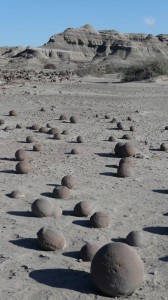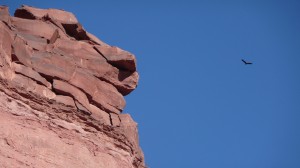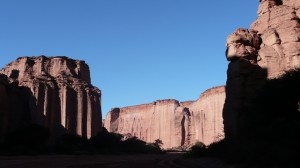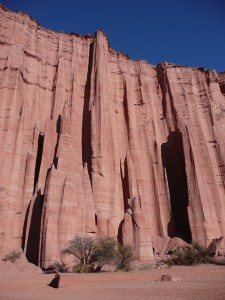Valle Fertil, Ischigualasto, Talampaya
by Bérna,
at 10:28
South America 2008 | permalink | rss
After leaving Mendoza we got to San Agustin de Valle Fertil, a small village the is known among travelers only for being the starting point for trips to the Ischigualasto (moon valley) and Talampaya parks. Once we got to hostel we met Thierry, a Fribourgeois we had met in Malargüe coupple of days ago and a Spanish couple. We spent the evening eating asado (typical Argentinian BBQ), drinking wine and watching Argentina vs. Brasil for the world cup qualification.

In the morning we leave for our long day visiting the two geologically incredible parks (UNESCO . Our first stop is at Ischigualasto, one of the only places where a complete superior triassic sediment series is visible. As well, the oldest dinosaur fossil was found here. The nickname of the site is valley of the moon, and as you can see on the pictures it is a very good nickname.
The place was formed (or better said put in this state) during the formation of the Andes around 100 mio years ago when the Nazca plate and the South american plate collided and created a subduction zone. The old triassic (250 to 205 mio years ago) lake sediments where then pushed up in a 45° angle by the subducting Nazca plate forming the nowadays visible series.
Ischigualasto is an incredible landscape marked by different colors like red, green, orange, yellow and gray coming from the different mineral composition of the sediments. Furthermore, the seasonally torrential rainsand the high winds create an extreme erosion that contributes in shaping the moon-like landscape.
After visiting the park’s museum where fossils and reconstructions of the oldest dinosaurs are shown we get on our van again and 2 hours later we’re at Talampaya.
Talampaya is geologically similar to Ischigualasto (although the series visible here are from the inferior triassic) but geomorphologically the two parks have nothing in common. In Talalmpaya the main erosion was (and is) fluvial, resulting in a huge canyon. At the beginning of the canyon we see some rock arts that show how the locals ancestors hunted and farmed guanacos (the local llama). The further we get into the canyon the more spectacular it gets, high walls of about 200m  with condors flying around and some vegetation at the bottom, very very cool! As well we experience the best echo ever, from a special spot (like a big u eroded into the wall) the canyon repeats full sentences up to four times.
with condors flying around and some vegetation at the bottom, very very cool! As well we experience the best echo ever, from a special spot (like a big u eroded into the wall) the canyon repeats full sentences up to four times.
Around six our driver drops us off at an intersection where a bus is supposed to pass by and take us to La Rioja and then to Salta. After two hours of waiting in the local store-restaurant-ticket office-bus stop house having some cheese and wine and counting 5 cars passing by, the bus arrives and we’re off to Salta.


No comments at the moment.
Add a comment